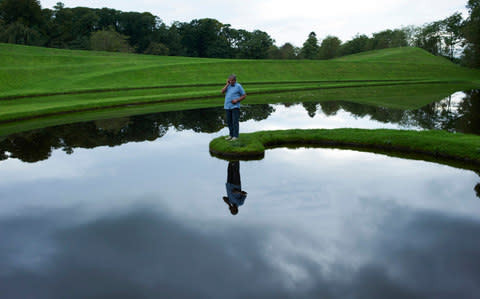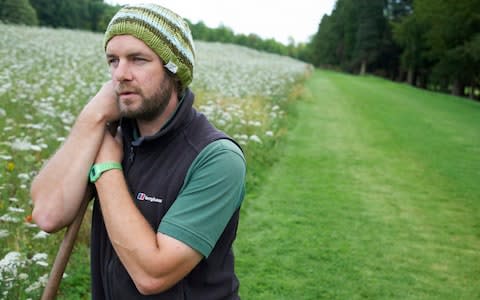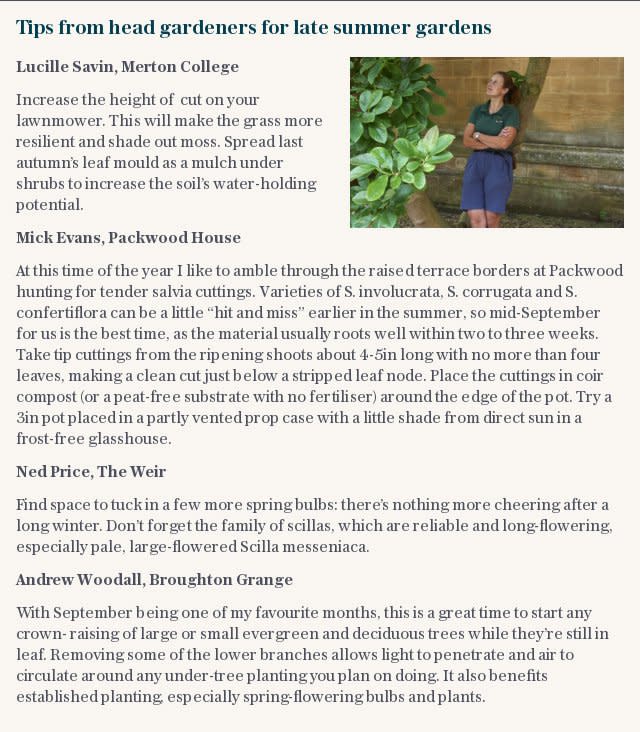Britain's head gardeners are a multi-talented lot: 'It's not a career for dimwits'

Before he clocks off tonight at Broughton Grange, Andrew Woodall will lock up the loos, feed his employer’s dog and set the alarm. At Merton College, Oxford, Lucille Savin is suddenly required to create a pond in one of her borders into which a corpse can be posted from an upstairs window. (The college plays host to numerous film crews.) At Portrack House, near Dumfries, Alistair Clark is contemplating the scale model he has built in his yard of a staircase depicting the evolution of the universe from the Big Bang, and wondering how he might turn this jagged construction of cement into a more or less acceptable water feature. In Cumbria, Martin Ogle is churning out 42 emails to drum up the volunteer workforce on which he depends. Then he’ll labour into the small hours over a blog.
It’s all in a day’s work for Britain’s most underrated profession, the head gardener.

What makes a really good head gardener? Over two years, I interviewed 14 outstandingly successful head gardeners and asked them all that question. Their response was unanimous – above all other things, gardening is about paying attention, careful observation and timely response. Then you need vision – the capacity to see where the garden will be one year, 10 years, sometimes 100 years from now. And patience – gardening is all about playing the long game. The notion of instant gardening, they agreed, is utter nonsense.
But what they also made clear, with considerable regret, is that for most head gardeners today, the actual business of growing is only a small part of their job. It is hard to think of a profession (except perhaps a vicar) that demands such breadth and variety of skills. For as well as able horticulturists, they may be artists, educators, conservationists, healers, historians, engineers, social workers, PR men – or any combination of the above. They have to know not only about plants, but machinery and drains, building regulations and health and safety. They need well-honed management skills, to run large workforces and substantial budgets.

They also need to be adaptable and quick-thinking: how many other managers have to respond to conditions that can change not only year by year, but day by day and hour by hour? Yet how many young people brandishing a clutch of shiny new A-levels will be urged to take up horticulture as a career? Type “head gardener” into the National Careers Service database, and nothing comes up. Type in “gardener” and it says “no qualifications required”.
This is the kind of thing that moves West Dean’s Jim Buckland to fury. “Gardening is not a career for dimwits,” he exclaims. He trained at Kew. Most head gardeners have degrees. Others, like Mick Evans of Packwood House, served exacting apprenticeships: working at Sissinghurst for the legendary Pam Schwerdt and Sibylle Kreutzberger, it was a full year before he was deemed sufficiently skilful, with an appropriately nuanced understanding of colour, to be let loose in the borders. The training paid off: today Mick is revered as an artist in the garden, wielding colour with the confidence and exuberance of a Jackson Pollock.
For others, their job is less about art than the natural environment. For Ned Price, head gardener at The Weir, in Herefordshire, gardening is a delicate two-step with the forces of nature – creating the conditions where birds, bees and bats can thrive, negotiating the ebb and flow of the ever-more unpredictable river that regularly inundates his land. For him, success is the sight of otter prints in the mud or twayblades (wild orchids) twinkling in the grass: he has been gardening for wildlife for nigh on four decades, and is wryly amused that it has become the Latest Thing.

Paul Pulford’s garden, on the roof of the Queen Elizabeth Hall on London’s South Bank, is also an oasis for wildlife, where rare migrating birds have been spotted among the native wild flowers and boxes of vegetables. But more than that, the garden is a sanctuary for people, created and maintained mainly by recovering substance abusers. Paul himself spent seven years living on the street, and turned to gardening as a means of soothing the agonies involved in conquering his heroin addiction.

Indeed it is striking how many head gardeners consider their job to be first and foremost about people. For Fergus Garrett (perhaps Britain’s best-known head gardener), Great Dixter, for all its spectacle, is less about horticultural showmanship than nurturing generosity of spirit. Lucille Savin revels in subverting expectations of a traditional college garden by growing brilliantly coloured sub-tropical exotica. But the primary role of the garden, for her, is as a decompression zone for over-stressed students.
And at Headley Court, the infinitely patient Carol Sales uses gardening to help rebuild, as far as possible, the shattered bodies and ravaged minds of serving military personnel, notably those injured in Afghanistan. Her greenhouse is a haven from the regimented hospital environment, where tending the tomatoes, pricking out seeds and picking flowers all help to restore lost motor skills. “I call it therapy by stealth,” she says. But mainly, she believes, gardening just makes people feel better.
As amateur gardeners, who can garden just when we like, we might be tempted to think being a head gardener is an easy job. Tell that to Andrew Woodall at Broughton Grange, establishing the biggest ornamental planting of trees for the past 100 years: keeping them watered, weeded and safe from pests is much like a military operation. Or to Michael Walker, now officially titled head of garden and estate at the Trentham Estate in Staffordshire. Recreating a degraded garden that had been the most famous in Britain in the 19th century – and adapting it for the 21st so that it should remain the pinnacle of horticultural achievement – were just the first of his challenges. Now he has to run it as a commercially viable tourist attraction, and, in attempting a restoration of Capability Brown’s landscape, make unpopular changes in the face of entrenched local views.
But at least Michael has a decent budget to work with. Not so Martin Ogle, who for the past four years has been busy at Lowther Castle in Cumbria, struggling to turn the ruined castle and 130 derelict acres into the major garden attraction in the North. He had barely started work when the contractors working on the project went bust, the garden budget was appropriated to make the castle building safe, and he found himself in charge of the biggest garden restoration project in Europe, with no staff and no budget whatsoever. He put together a stalwart band of volunteers, but just as progress was being made, the torrential winter storms of 2015 that swept away nearby Pooley Bridge also smashed into the garden, splintering Lowther’s ancient yew avenue, sweeping away paths and felling landmark trees which had stood for 400 years.
It did add somewhat to the workload, Martin concedes laconically, but it never occurred to him to give up. That’s the thing about head gardeners – they are wedded to their work. “You’ll never be a rich man, being a gardener,” declares Martin, “but you’ll definitely be a happy, happy man.”



